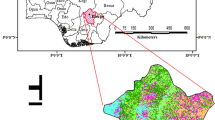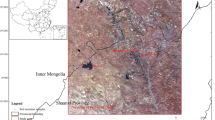Abstract
A set of indicators that focus only on numerical values is constructed based on remotely sensed images to assess soil moisture conditions. The quantitative evaluation of soil moisture variation in two periods is rarely referred to in the current literature. In this study, a scaled soil moisture monitoring index (SSMMI) was established to monitor the soil moisture status during 2010–2018 in the Daliuta Coal Mining Area (DCMA), China, based on SPOT-5, SPOT-6, and Sentinel-2 images. We also employed a gradient-based structural similarity (GSSIM) algorithm to quantitatively analyze the characteristics of the spatial distribution of the soil moisture in the DCMA. The optimal scale for exploring the spatial heterogeneity of the soil moisture was determined by local variance and semivariance methods. The results showed that the soil moisture decreased at a rate of 0.0213/a from 2010 to 2018. The areas with the extremely dry and dry levels, which were mainly located in the northwest, some regions of the central area, and the southeast of the DCMA, decreased from 14.48% in 2010 to 13.66% in 2018. The proportion of the no dry level was improved by 14.62%, while the area of the extremely wet and wet levels decreased by 13.79%. The mean value of the soil moisture in the unmined area was greater than that in the DCMA, which was larger than that in the mined area. The result of the GSSIM analysis indicated that the area of dramatic change, where the soil moisture changed substantially, was chiefly distributed in the north, west, some central regions, and some parts of the south and east of the DCMA. The region where the substantial change occurred was surrounded by a moderate-change area, which was encompassed by a low-change area. The area with dramatic and moderate decreases in the soil moisture accounted for 64.52% of the region, which was greater than that with incremental soil moisture changes, which accounted for 5.85% of the region. The area also showed decreased soil moisture from 2010 to 2018. Soil moisture changes are closely related to variations in land cover. For instance, vegetative cover over an open-pit mining area can cause a dramatic reduction in soil moisture. Ninety-three meters was the optimal scale used for monitoring the soil moisture in the DCMA, which indicates that we can adopt the SPOT-5, SPOT-6, and Sentinel-2 images to evaluate the soil moisture conditions in the DCMA.












Similar content being viewed by others
References
Al-Yaari, A., Wignerona, J. P., Dorigo, W., Colliander, A., Pellarin, T., Hahn, S., Mialon, A., Richaum, P., Fernandez-Moran, R., Fan, L., Kerr, Y. H., & Lannoy, G. D. (2019). Assessment and inter-comparison of recently developed/reprocessed microwave satellite soil moisture products using ISMN ground-based measurements. Remote Sensing of Environment, 224, 289–303.
Amani, M., Parsian, S., Mirmazloumi, S. M., et al. (2016). Two new soil moisture indices based on the NIR-red triangle space of Landsat-8 data. International Journal of Applied Earth Observation, 50, 176–186.
Amani, M., Salehi, B., Mahdavi, S., Masjedi, A., & Dehnavi, S. (2017). Temperature-vegetation-soil moisture dryness index (TVMDI). Remote Sensing of Environment, 197, 1–14.
Amazirh, A., Merlin, O., Er-Raki, S., Gao, Q., Rivalland, V., Malbeteau, Y., Khabba, S., & Escorihuela, M. J. (2018). Retrieving surface soil moisture at high spatio-temporal resolution from a synergy between Sentinel-1 radar and Landsat thermal data: A study case over bare soil. Remote Sensing of Environment, 211, 321–337.
Anne, N. J. P., Abd-Elrahman, A. H., Lewis, D. B., et al. (2014). Modeling soil parameters using hyperspectral image reflectance in subtropical coastal wetlands. International Journal of Applied Earth Observation, 33, 47–56.
Awe, G. O., Reichert, J. M., Timm, L. C., et al. (2015). Temporal processes of soil water status in a sugarcane field under residue management. Plant & Soil., 387, 395–411.
Bauer-Marschallinger, B., Freeman, V., Cao, S. M., Paulik, C., Schaufler, S., Stachl, T., Modanesi, S., Massari, C., Ciabatta, L., Brocca, L., & Wagner, W. (2019). Toward global soil moisture monitoring with Sentinel-1: Harnessing assets and overcoming obstacles. IEEE Transactions on Geosicence and Remote Sensing, 57(1), 520–539.
Benabdelouahab, T., Balaghi, R., Hadria, R., Lionboui, H., Minet, J., & Tychon, B. (2015). Monitoring surface water content using visible and short-wave infrared SPOT-5 data of wheat plots in irrigated semi-arid regions. International Journal of Remote Sensing, 36(15), 4018–4036.
Bogena, H. R., Huisman, J. A., Oberdörster, C., et al. (2007). Evaluation of a low-cost soil water content sensor for wireless network applications. Journal of Hydrology, 344, 32–42.
Boroumand, A., Rajaee, T., & Masoumi, F. (2017). Semivariance analysis and transinformation entropy for optimal redesigning of nutrients monitoring network in San Francisco bay. Marine Pollution Bulletin, 129, 689–694.
Carlson, T. (2007). An overview of the "triangle method" for estimating surface evapotranspiration and soil moisture from satellite imagery. Sensors., 7, 1612–1629.
Deng, Y., Wang, J., Ma, R., 2013. Dynamic monitoring of vegetation coverage in Shangri-La County of Northwest Yunnan based on MODIS-NDVI. 21st international conference on Geoinformatics, Kaifeng, 1–5.
Ghulam, A., Qin, Q., & Zhan, Z. (2007a). Designing of the perpendicular drought index. Environmental Geology, 52, 1045–1052.
Ghulam, A., Qin, Q., Teyip, T., et al. (2007b). Modified perpendicular drought index (MPDI): a real-time drought monitoring method. ISPRS Journal of Photogrammetry and Remote Sensing, 62, 150–164.
Gillies, R. R., Kustas, W. P., & Humes, K. S. (1997). A verification of the ‘triangle’ method for obtaining surface soil water content and energy fluxes from remote measurements of the normalized difference vegetation index (NDVI) and surface radiant temperature. International Journal of Remote Sensing, 18(15), 3145–3166.
Houser, C. A. (2011). Soil moisture: A central and unifying theme in physical geography. Progress in Physical Geography, 35, 65–86.
Istanbulluoglu, E., & Bras, R. L. (2006). On the dynamics of soil moisture, vegetation, and erosion: Implications of climate variability and change. Water Resources Research., 42, 650–664.
Jiang, M., & Lin, Y. (2018). Desertification in the south Junggar Basin, 2000–2009: Part I. spatial analysis and indicator retrieval. Advances in Space Research, 62, 1–15.
Kahle, A. B. (1977). A simple thermal model of the Earth's surface for geologic mapping by remote sensing. Journal of Geophysical Research, 82, 1673–1680.
Latif, Z.A., Zamri, I., Omar, H., 2012. Determination of tree species using Worldview-2 data. IEEE 8th international colloquium on signal processing and its applications, Melaka, 383-387.
Liang, W. L., Hung, F. X., Chan, M. C., et al. (2014). Spatial structure of surface soil water content in a natural forested headwater catchment with a subtropical monsoon climate. Journal of Hydrology, 516, 210–221.
Lin, H. (2010). Earth's critical zone and hydropedology: Concepts, characteristics, and advances. Hydrology and Earth System Sciences, 6, 3417–3481.
Liu, Y., & Yue, H. (2018). The temperature vegetation dryness index (TVDI) based on bi-parabolic NDVI-Ts space and gradient-based structural similarity (GSSIM) for long-term drought assessment across Shaanxi province, China (2000–2016). Remote Sensing, 10(6), 959.
Liu, Y. Y., Parinussa, R. M., Dorigo, W. A., et al. (2011). Developing an improved soil moisture dataset by blending passive and active microwave satellite-based retrievals. Hydrology and Earth System Sciences, 15, 425–436.
Liu, Y., Wu, L. X., & Ma, B. D. (2013). Remote sensing monitoring of soil moisture on the basis of TM/ETM + spectral space. Journal of China University of Mining and Technology, 42, 296–301 (In Chinese).
Liu, Y., Yue, H., Wang, H. R., & Zhang, W. (2017). Comparison of SMMI, PDI and its applications in Shendong mining area. IOP Conference Series: Earth and Environmental Science, 57, 012025.
Loew, A., Ludwig, R., & Mauser, W. (2006). Derivation of surface soil moisture from ENVISAT ASAR wide swath and image mode data in agricultural areas. IEEE Geoscience and Remote Sensing, 44, 889–899.
Moran, M. S., Clarke, T. R., Inoue, Y., et al. (1994). Estimating crop water deficit using the relation between surface-air temperature and spectral vegetation index. Remote Sensing of Environment, 49, 246–263.
Pan, M., Sahoo, A. K., & Wood, E. F. (2014). Improving soil moisture retrievals from a physically-based radiative transfer model. Remote Sensing of Environment, 140, 130–140.
Peng, J., Loew, A., Zhang, S., et al. (2015a). Spatial downscaling of satellite soil moisture data using a vegetation temperature condition index. IEEE Transactions on Geoscience and Remote Sensing, 54, 558–566.
Peng, J., Niesel, J., & Loew, A. (2015b). Evaluation of soil moisture downscaling using a simple thermal based proxy - the REMEDHUS network (Spain) example. Hydrology and Earth System Sciences, 12, 8505–8551.
Petropoulos, G. P., Ireland, G., & Barrett, B. (2015). Surface soil moisture retrievals from remote sensing: Current status, products & future trends. Physics & Chemistry of the Earth Parts A/b/c., 83-84, 36–56.
Price, J. C. (1985). On the analysis of thermal infrared imagery: The limited utility of apparent thermal inertia. Remote Sensing of Environment, 18, 59–73.
Romano, N. (2014). Soil moisture at local scale: Measurements and simulations. Journal of Hydrology, 516, 6–20.
Sandholt, I., Rasmussen, K., & Andersen, J. (2002). A simple interpretation of the surface temperature/vegetation index space for assessment of surface moisture status. Remote Sensing of Environment, 79, 213–224.
Seneviratne, S. I., Corti, T., Davin, E. L., et al. (2010). Investigating soil moisture-climate interactions in a changing climate: A review. Earth-Science Reviews, 99, 125–161.
Topp, G. C., & Reynolds, W. D. (1998). Time domain reflectometry: A seminal technique for measuring mass and energy in soil. Soil and Tillage Research ., 47, 125–132.
Wagner, W., Bloschl, G., Pampaloni, P., et al. (2007). Operational readiness of microwave remote sensing of soil moisture for hydrologic applications. Water Policy, 38, 1–20.
Wang, L., & Qu, J. J. (2009). Satellite remote sensing applications for surface soil moisture monitoring: A review. Frontiers of Earth Science in China., 3, 237–247.
Woodcock, C. E., & Strahler, A. H. (1987). The factor of scale in remote sensing. Remote Sensing of Environment, 21, 311–332.
Zhang, D., & Zhou, G. (2016). Estimation of soil moisture from optical and thermal remote sensing: A review. Sensors., 16, 1308.
Zhang, B., Jiao, Q., & Li, Q. (2012). Application of hyperspectral remote sensing for environment monitoring in mining areas. Environment and Earth Science, 65, 649–658.
Zhang, D., Li, Z. L., Tang, R., et al. (2015). Validation of a practical normalized soil moisture model with in situ measurements in humid and semi-arid regions. International Journal of Remote Sensing, 36, 5015–5030.
Zribi, M., Gorrab, A., Baghdadi, N., et al. (2013). Influence of radar frequency on the relationship between bare surface soil moisture vertical profile and radar backscatter. IEEE Geoscience and Remote Sensing Letters, 11, 848–852.
Funding
This work was jointly supported by the National Natural Science Foundation of China (41401496); Xi’an University of Science and Technology (2019YQ3-04); Key Laboratory of Mine Geological Hazards Mechanism and Control (6000180096 and KF2018-04).
Author information
Authors and Affiliations
Contributions
Hui Yue and Ying Liu conceived the idea and wrote the paper; Jiaxin Qian helped with the algorithm.
Corresponding author
Ethics declarations
Conflict of interest
The authors declare that they have no conflicts of interest.
Additional information
Publisher’s note
Springer Nature remains neutral with regard to jurisdictional claims in published maps and institutional affiliations.
Rights and permissions
About this article
Cite this article
Yue, H., Liu, Y. & Qian, J. Soil moisture assessment through the SSMMI and GSSIM algorithm based on SPOT, WorldView-2, and Sentinel-2 images in the Daliuta Coal Mining Area, China. Environ Monit Assess 192, 237 (2020). https://doi.org/10.1007/s10661-020-8174-9
Received:
Accepted:
Published:
DOI: https://doi.org/10.1007/s10661-020-8174-9




